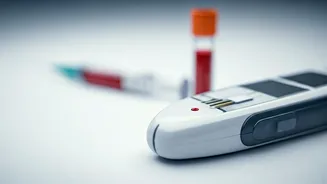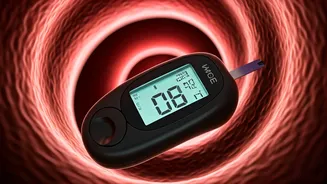Unusual Skin Issues
One of the less obvious indications of uncontrolled blood sugar is the appearance of skin issues. These can manifest in diverse ways, including frequent
skin infections, such as boils and carbuncles. Also, unexplained patches of dark, velvety skin, often found in the folds of the neck, armpits, and groin, can be a symptom, which is known as acanthosis nigricans. Furthermore, slow-healing wounds or sores are common. The elevated glucose in the blood can impair the body's ability to heal efficiently. People with poorly managed diabetes often experience dry, itchy skin, which can become problematic. These skin problems may be subtle, but they're important clues. Consistent monitoring and management of blood sugar levels can help in preventing and addressing these issues.
Vision Changes
Another less commonly known indication of potentially elevated blood sugar levels involves vision. Fluctuations in blood glucose can lead to blurred vision, which might come and go. When blood sugar levels are high, the lens of the eye can swell, temporarily altering vision. Prolonged high blood sugar levels can cause damage to the small blood vessels in the retina, a condition known as diabetic retinopathy. Early stages of retinopathy may not produce symptoms, making regular eye check-ups crucial. Also, sudden changes in eyesight, particularly in those with diabetes, should be taken seriously and investigated. Keeping blood sugar levels within a healthy range can help to prevent or slow down these vision-related complications. If you have concerns, consult a healthcare provider.
Frequent Infections
Individuals with poorly controlled blood sugar often encounter a higher frequency of infections. This is due to the fact that high glucose levels impair the immune system’s ability to function correctly. Common infections include those of the urinary tract and yeast infections, which can be particularly persistent and difficult to treat. Moreover, skin infections and dental problems, such as gum disease, are more common. The increased presence of glucose creates an ideal environment for bacteria and fungi to thrive. Thus, the immune system is weaker in dealing with these pathogens. Managing blood sugar levels through diet, exercise, and medication as needed, is vital in lowering the frequency and severity of infections. Consulting a healthcare professional promptly at the first sign of an infection is essential.
Unexplained Fatigue
Persistent fatigue, or feeling unusually tired, can be a subtle sign of uncontrolled blood sugar. This tiredness might not be relieved by rest, making it challenging to manage daily activities. When blood sugar levels are high, the body’s cells don’t get enough glucose from the blood, which results in a lack of energy. Fluctuations in blood sugar levels can also lead to energy crashes and feelings of exhaustion throughout the day. Although many factors contribute to fatigue, if you have diabetes or suspect you might, experiencing persistent tiredness is a reason to evaluate your blood sugar control. Regularly monitoring blood sugar levels, keeping a balanced diet, and making sure you get enough sleep, are vital actions to take.
Slow Healing
One of the more obvious but still sometimes overlooked indicators of poorly controlled blood sugar is slow wound healing. High blood sugar can damage the blood vessels and nerves, which makes it harder for wounds and cuts to heal properly. Even minor cuts and scrapes can take longer than usual to heal, making them susceptible to infection. The body’s immune response is less effective. This can lead to serious complications. Regularly checking your feet for any cuts or sores is essential, particularly for people with diabetes. Any wounds should be cleaned and managed properly. Make sure to consult with a healthcare professional for proper care. The healing process can be improved by maintaining proper blood sugar control.











